Top 10 Underrated Towns in Italy for 2020: Get off the well-trodden track
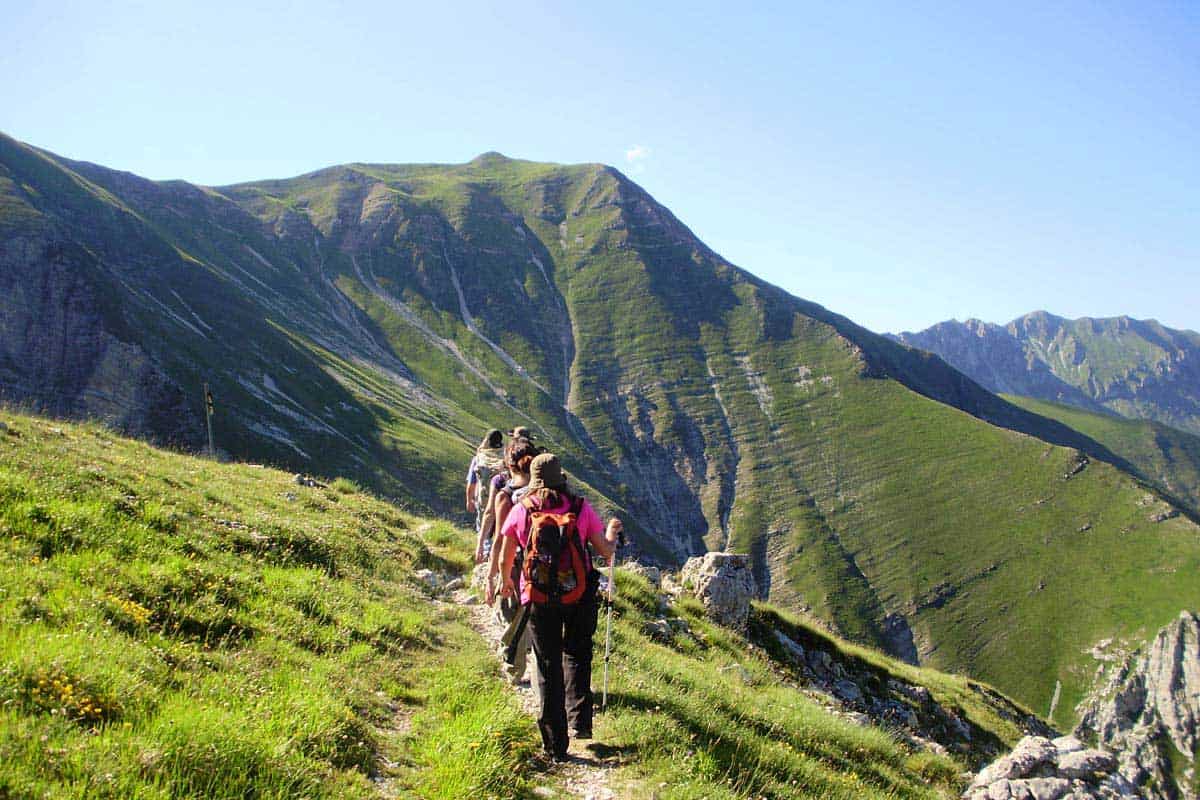
Conde Nast came out with its annual Readers Choice list for the world’s best countries and Italy came out ninth. Italy appearing in a top 10 list is like Alabama football, U.S. billionaires and Harvard. Conde Nast called Italy the “evergreen country.” It’s always there.
It’s why I’m here. And I’m not leaving. Next month I will enter my seventh year in Italy, my ninth over two stints, and not a calendar gets tossed without me discovering new hidden hideaways I’d never heard or read about. It might be while driving along a rural road in Lazio’s wine country or taking a boat through Lake Como, trying to decide what lakeside ville to spend the night.
You know you want to visit in 2020. You either want to return to that piazza in Florence where you had the best pizza of your life or saw some Anthony Bourdain gastro tour of Rome.
You realize, of course, there will be about 50 million others who will visit Italy next year. Yes, there is a way to get away from them. Read this. It’s my fourth annual Italy Off-the-Beaten-Path List. Along with my 2017, 2018 and 2019 blogs, this list is compiled mostly from places I visited this year. I also threw in a couple of old favorites I rediscovered when I closed my eyes and dreamed of my glorious past few years in Italy.
So cut and paste this link, put it on your computer and use it as your driving force when you want to kill your boss or are tired of mowing your lawn. I’m always available to help bedraggled fellow Americans.
(This list is in alphabetical order as making a top 10 list is like listing my 10 favorite gelato flavors. It also includes links to bigger blogs I wrote on specific areas.)

Arquata del Tronto (pop. 1,000)
The town isn’t much. It’s merely a small principality. However, it’s the perfect jumping off point for Parco Nazionale dei Monti Sibillini. It is little-known national park that borders the underrated regions of Abruzzo and Le Marche. It is 173,000 acres of green meadows bridging mountains in the Apennine mountain range, including 5,435-foot Mont Guaidone which hovers over the area.
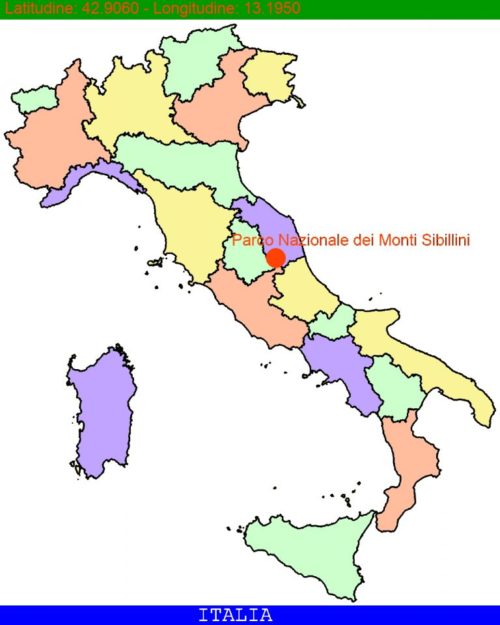
In June, the park rivals New England’s fall for raw natural beauty. Wildflowers of purple, red and yellow fill the meadows. A 75-mile hiking loop encircles the park which features nine refugios to crash for the night. My Rifugio Colle Le Cese, 15 miles southwest of town, supplied sandwiches for my hikes. Or go to Norcia, 15 miles away, which boasts the best sausage in Italy and has mostly recovered from the 2016 earthquake.
Arquata del Tronto is three hours by car north of Rome’s Fiumicino airport but can be reached by bus from Ascoli Piceno, also on the Abruzzo-Le Marche border.
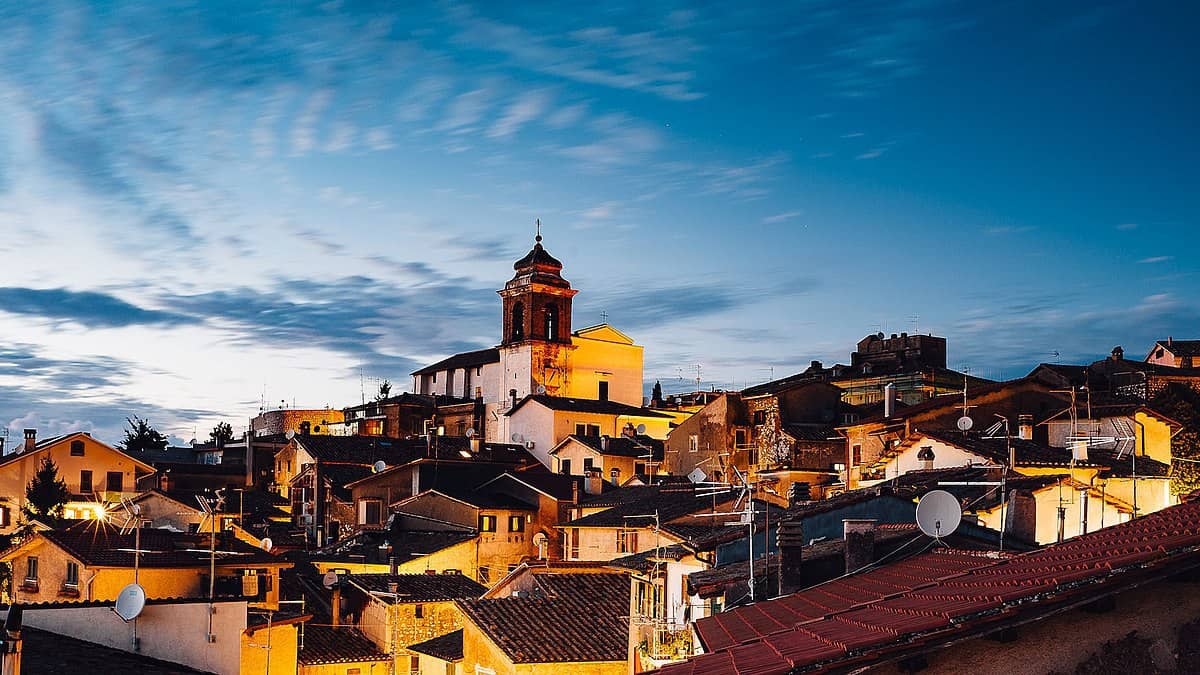
Castel San Pietro Romano (pop. 883)
This is my favorite find of 2019 and one of my best discoveries in Italy. Marina and I stayed in a bed & breakfast about 10 miles down the road from here during an August blog about the rise of Lazio wines. This tiny village is situated at 2,500 feet 22 miles east of Rome and high above the emerald Valle del Sacco. It’s an easy day trip but you must spend the night to grasp the heartbeat of rural Italy.
It’s a collection of alleys and narrow roads all leading to a small central piazza and with great views of the valley below. The 16th century San Pietro Apostolo with its statues of capuchin monks anchors a small square.
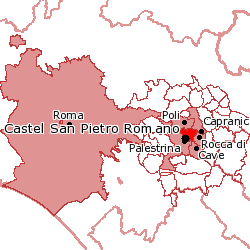
In 2017 the town was listed among the Most Beautiful Villages of Italy and 100 top destinations of Italy.
It has come a long way since post-World War II when Italian directors flocked there to film the ruined village as a raw example of Italy’s economic despair. Since then it has become a beacon for Italian films with photos adorning the town walls where scenes were shot. One includes “Pane, Amore e Fantasia,” the 1953 breakout film of Gina Lollobrigida.
Have a cheap glass of wine at an outside table at Bar al Caffe then go around the corner to Ristorante Gasbarri for some of the most authentic Roman cuisine in Lazio.
The town can be reached by bus from Rome’s Termini station with a change at Palestrina.
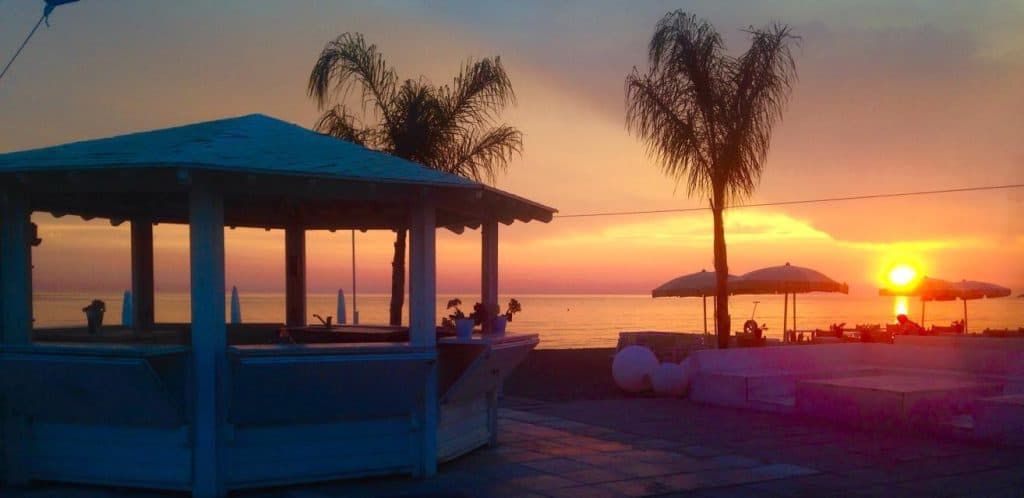
Fregene (pop.6,445)
Coming to Rome in July and August? Don’t. It’s hot and crowded. But if you must, come to Fregene on July weekdays or early in the day in August. It’s my favorite quick beach getaway, just 25 miles southwest of Rome and 20 miles north of the airport in Fiumicino.
Marina and I often drive early and park free in the back lot of Il Capanno dei Pescatori, one of a number of outstanding seafood restaurants along the beach. It has semi-elegant outdoor seating in the sand with terrific seafood pasta dishes and fresh fish at affordable prices you can’t get in Rome. Parking is free if you rent the restaurant’s lounge chairs for about 7 euros on a spotless, sandy beach along a clean Tyrrhenian Sea. Come on a weekday morning in June or September and you may have the place to yourself.
Drive along the narrow roads lined with little beach bungalows and it may remind you of Venice — the one in California — without the schlocky souvenir stands.
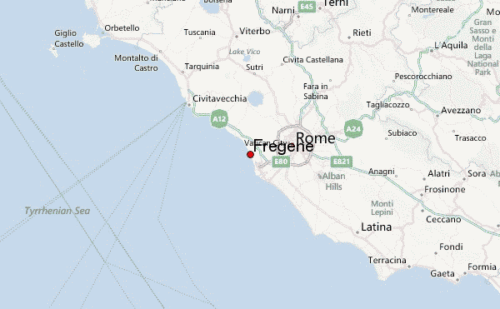
This area was once a swamp until 1928 when Benito Mussolini, who did a couple of good things before befriended a guy named Adolf Hitler, made it part of his large drainage project. It became one of the many sea resorts along the Tyrrhenian and it has remained as such to this day.
Fregene can be reached by train on the Rome-Pisa line but the Maccarese-Fregene train station is about 2.5 miles from the beach. It’s best to rent a car.
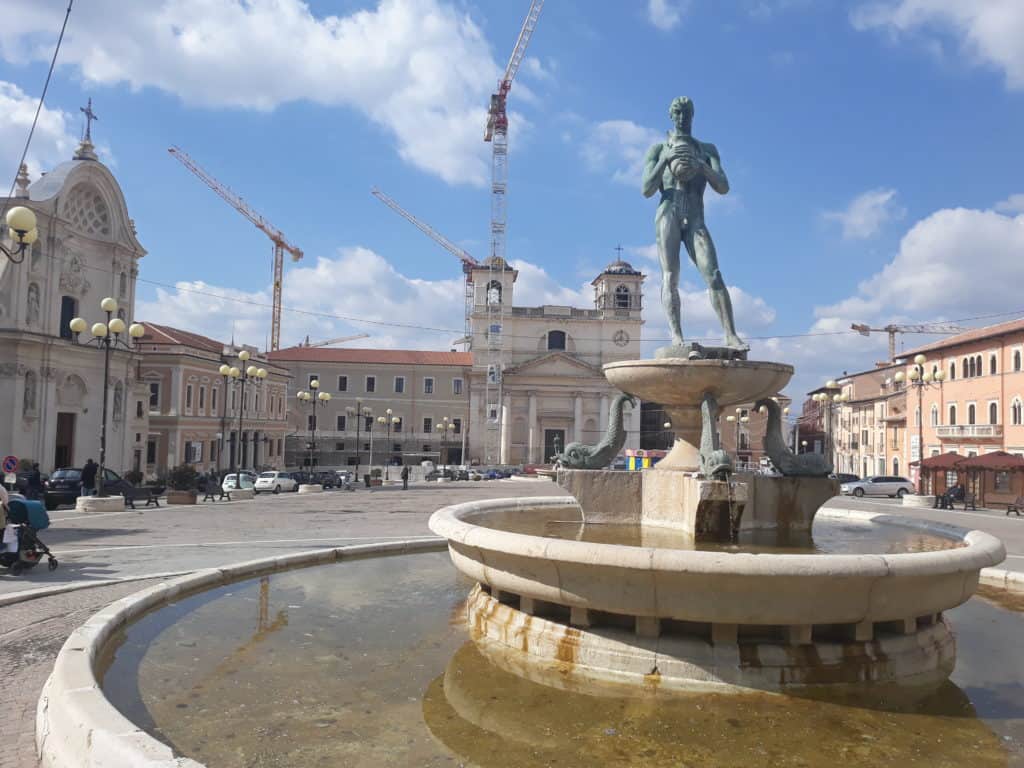
L’Aquila (pop. 70,000)
Its comeback is nearly complete. No, not many ventured into the capital of lightly trodden Abruzzo after the 2009 earthquake killed 308, injured 1,500, damaged 10,000 buildings and left 65,000 homeless.
But I came for the first time in August and shiny new buildings have replaced those that were destroyed. Corso Federico II, part of L’Aquila’s main drag, is lined with upscale shops. Piazza Duomo is again bustling with activity from lovers on a stroll to teens eating gelato in the shadow of the restored Duomo.
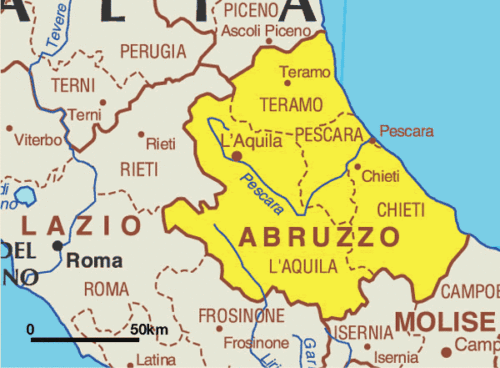
Cranes still loomed over the piazza and many buildings remain shells. A hole is all that remains of a dormitory where 25 university students were killed. It now serves as a memorial with signs and photographs and gifts left along a Cyclone fence.
But what attracted intrepid travelers to L’Aquila before is bringing them back again. It’s a pretty city, with a cool climate at 2,340 feet at the base of the Apennine mountains and restaurants slinging underrated Abruzzese wine and cuisine. Go down and stroll the tree-lined streets, then go to the piazza and enter the Chiesa di Santa Maria di Suffragio and read the names of the 308 quake victims on a plaque.
A Flixbus from Rome’s Tiburtina station reaches L’Abruzzo in about two hours.
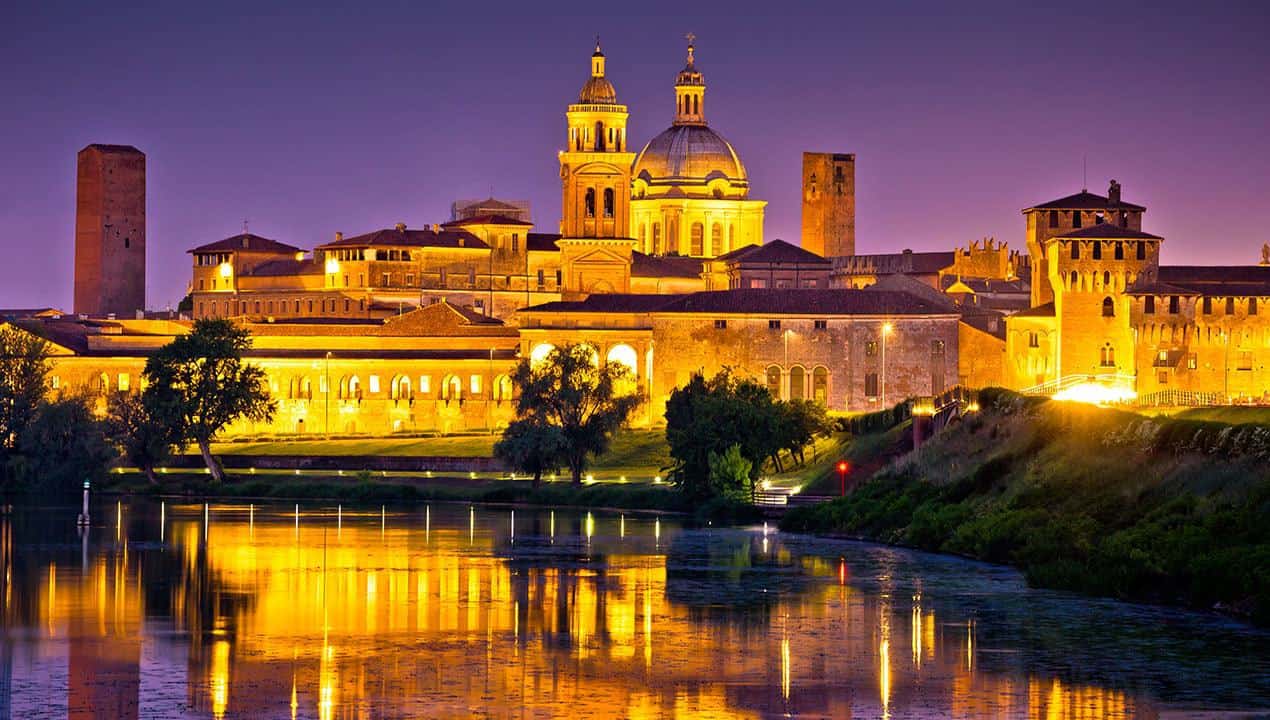
Mantua (pop. 48,000)
On the southern end of Lombardy on the Emilia-Romagna border, Mantua is too often skipped past on people’s way to Milan or Verona. It’s worth a day or two. While mainstream American tourists don’t know it, European culture vultures do. In 2007, Mantua’s old town was named a UNESCO World Heritage Site. In 2011 Lagambiente, Italy’s environmental association, ranked Mantua as the best Italian city for quality of life and environment. In 2016, it was named the Italian Capital of Culture and in 2017 the European Capital of Gastronomy.
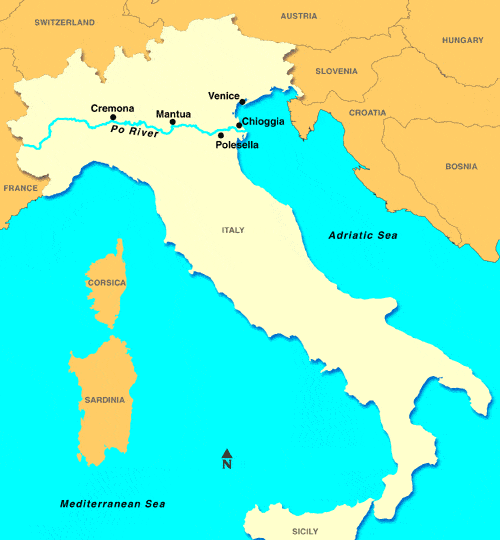
What makes Mantua so special? It’s at the confluence of three 12th century artificial lakes, making it feel as if you are on the sea even though you’re 80 miles inland. The influence of the Gonzaga family, which ruled Mantua from 1328-1708, made Mantua a center for culture, art and music.
The many palazzos and piazzas attracted numerous artists, including Paul Reubens. In a way it also housed William Shakespeare who was exiled to Mantua in his “Romeo and Juliet.”
Mantua is 290 miles from Rome and 115 from Milan.
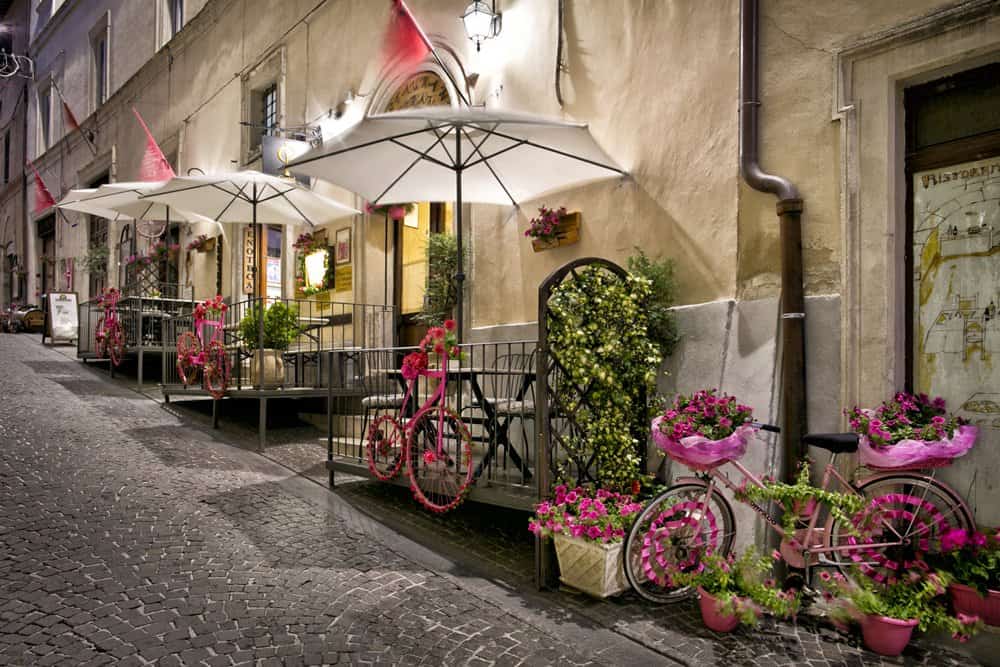
Montefalco (pop. 5,580)
Want a unique, Italian wine experience? Set up camp here. It’s in Umbria, one of Italy’s most underrated wine regions where its signature Sagrantino wine is making inroads around the world. The Sagrantino grape is grown only in Umbria and the area around Montefalco boasts 63 wineries. Rent a car, cruise around and meet winemakers in uncrowded tasting rooms.

Come in February during the annual Anteprima Sagrantino wine fair.
Montefalco is a typical Umbrian town. It’s inside a 12th century wall with narrow cobblestone streets leading to a main square anchored by a huge church. Chiesa di San Francesco features frescoes showing the life of St. Francis, whose church in Assisi is only 20 miles to the north.
If your budget permits, stay at the Villa Pambuffetti, a four-star palace in the midst of 27,000 square feet of gardens. Inside the town walls, dine at Olevm (Latin for “oil”) where they serve a mean chicken in Sagrantino sauce.
Montefalco is a 90-minute drive north of Rome but can be reached by train from Termini or bus from Tiburtina station.
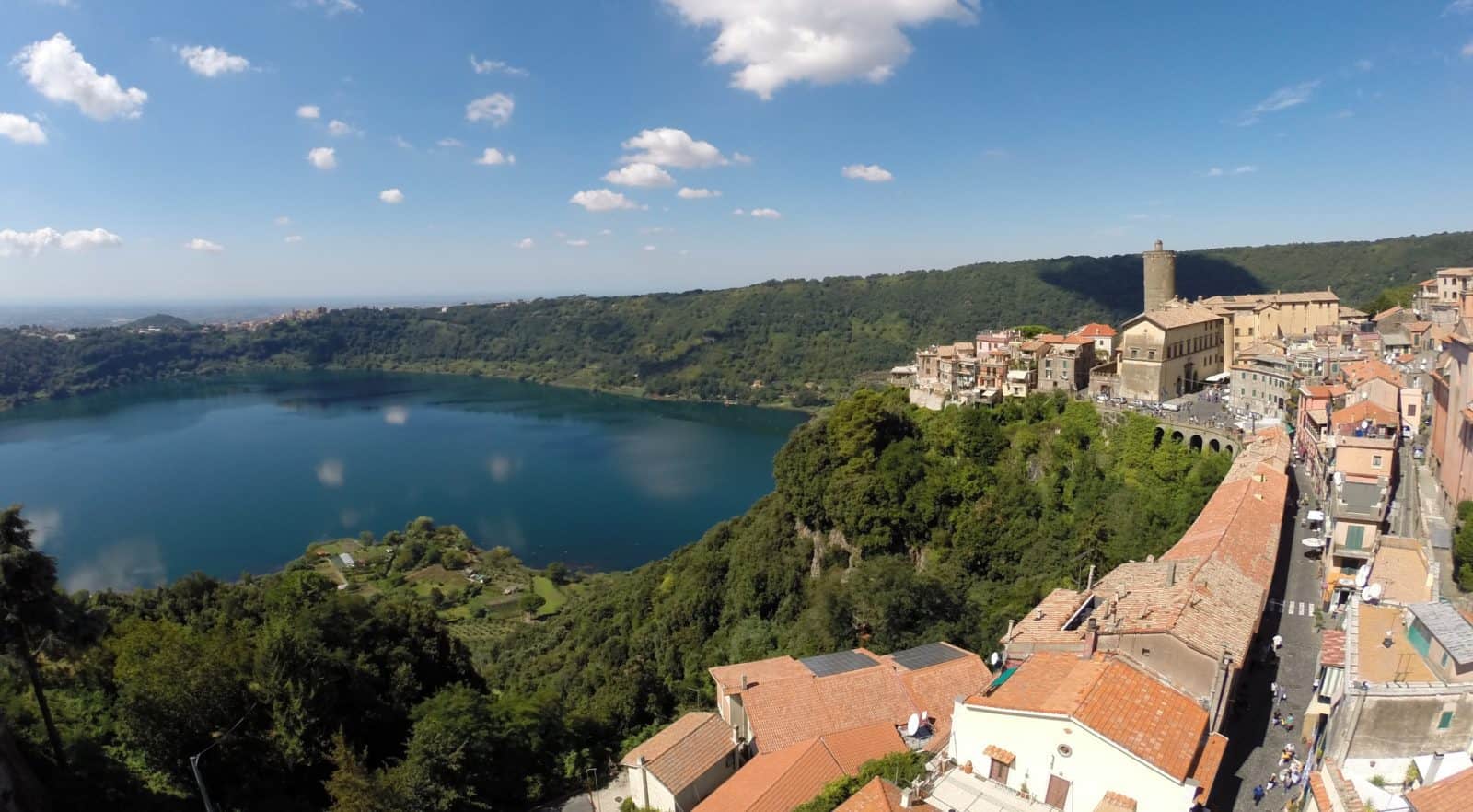
Nemi (pop. 1,900)
This is part of Castelli Romani, a string of seven towns in the Alban Hills southeast of Rome. At 1,700 feet it offers a cool respite from Rome’s summer heat. It is famous for two things: Its strawberries are among the sweetest in Europe, much more delicious than what you get in the stores. Half the businesses in the town seem to sell strawberry tarts, strawberry pies, strawberry gelato and strawberries, period.
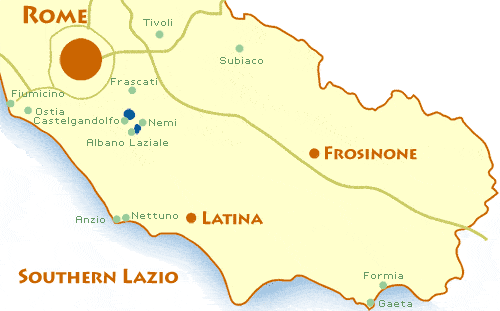
It’s also famous for Lake Nemi, a volcanic crater lake that provides some of the best views in Italy. Walk along Nemi’s narrow main drag and see the lake below, as still as glass and just as clear. Walk down the path 10 minutes for a closer look or go to the banks and dine at one of the restaurants.
The lake has quite a history. In 300 BC, it was the site of a temple that covered 11 acres. The temple, dedicated to Diana, the goddess of the hunt, became a pilgrimage from all over the Italian peninsula.
Later, Emperor Caligula (37-41 AD) built expensive barges on the lake for his luxury yachts. Mussolini had them salvaged but, alas, the boats were destroyed by fire in 1944.
You can reach Nemi by train via Albano Laziale and Genzano.
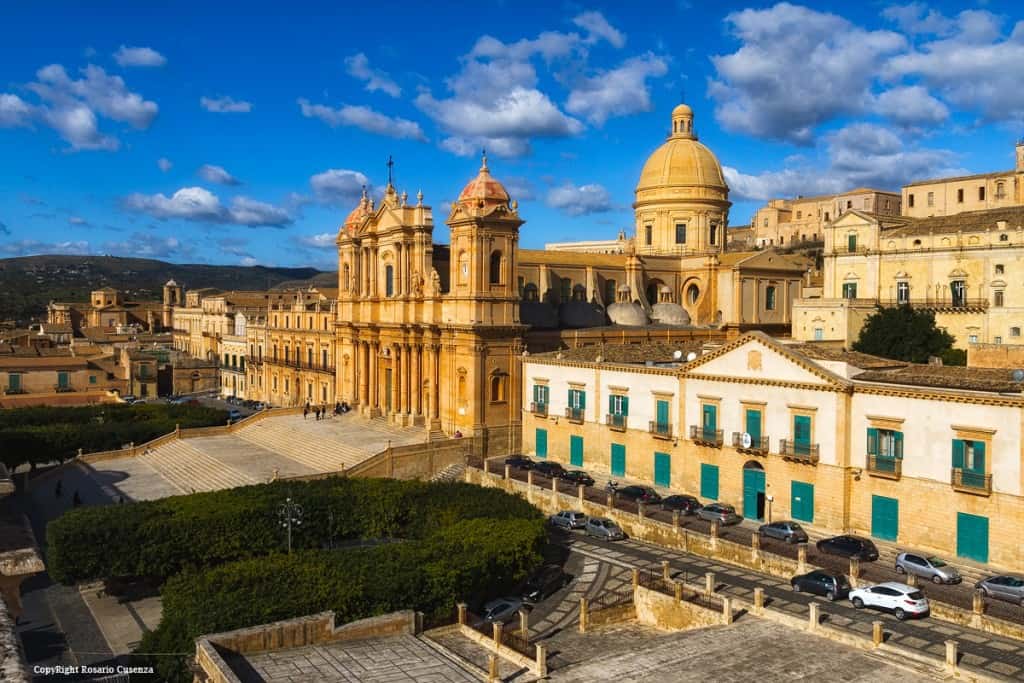
Noto (pop. 24,000)
If you’re into architecture come here. It’s part of the Baroque Triangle in southeast Sicily. Noto, along with Ragusa and Modica. are dripping with the Baroque style that surfaced in the 16th century to show off the Catholic Church’s massive wealth.

I went through all three during my 60th birthday three years ago and Noto is the most scenic. Walk through the giant archway and stroll down the pedestrian-only Corso Vittorio Emanuele. It’s lined with churches and palaces in the garish (or gorgeous, depending on your perspective) architecture. Lots of gold domes, wide staircases, huge churches such as Chiesa di San Domenico and St. Nicholas Cathedral.
Take a seat at one of the many outdoor trattorias and dig into my favorite regional cuisine in Italy, heavy on seafood and delicious desserts. Then go shop for ceramics with traditional Sicilian designs.
This area of Sicily, particularly Noto, has made a remarkable comeback from a 1693 earthquake that registered 7.3 and killed 60,000 people. It was rebuilt in the Baroque style and has attracted art historians for centuries.
However, few tourists bother coming here. They hit Taormina up the coast and Syracuse 20 miles away. Public transport in Sicily is spotty for the Baroque Triangle. Fly into Catania and rent a car.
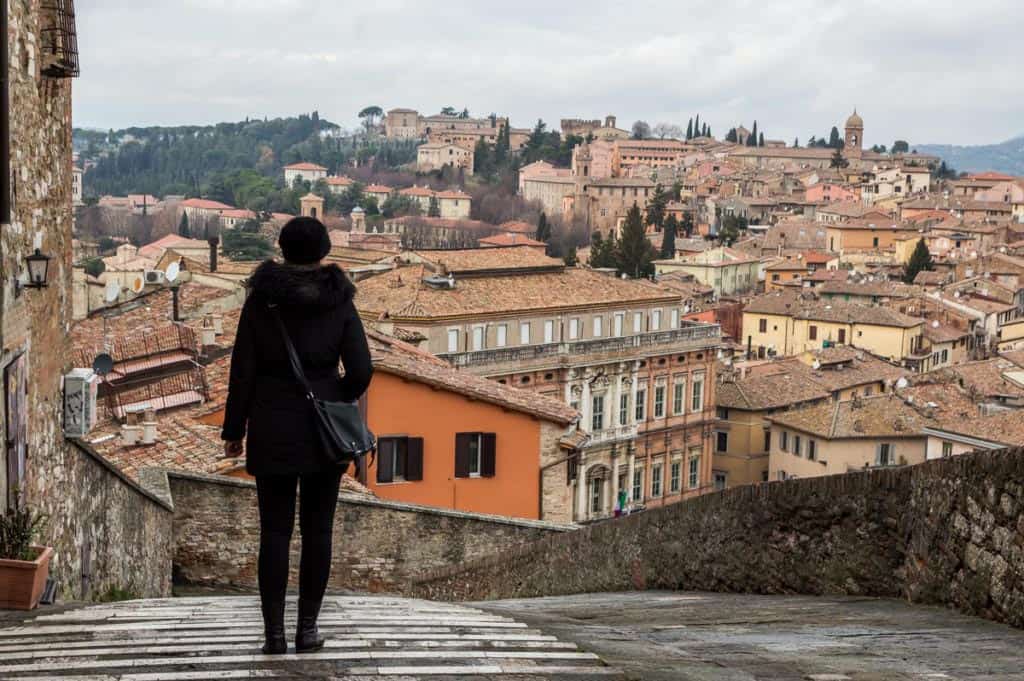
Perugia (pop. 165,000)
Maybe it’s a stretch to list a city of 165,000 people as off the beaten path. If you’re a chocolate lover, you may have beaten a path to Perugia every spring when it holds its gargantuan Eurochocolate festival.

But this beautiful, hilltop walled city, only 100 miles north of Rome, is often overlooked on the Rome-Florence-Venice tourist pilgrimage. It’s in the heart of Umbria, another underrated region.
You enter Perugia via escalator and walkway through a string of long, dark tunnels, built in the 1540s and tabbed the Rocca Paolina. It spits you out onto huge Piazza della Repubblica where Corso Vannucci leads you past Palazzo dei Priori, a 14th century palace holding the city’s main art gallery.
Continue down the street to the National Gallery of Umbria in Piazza IV Novembre and to San Lorenzo, a medieval cathedral from the 900s that overlooks the piazza.
Sightsee during the day; party at night. Perugia is one of Italy’s main university towns and the city is brimming with happening pubs, bars and cafes. For a mini ghoul tour, check out the house where Amanda Fox was accused, convicted then acquitted of murder in a sex game that went bad with other students.
Take little Via delle Streghe off Vannucci and try typical Umbrian cuisine such as cinghiale (wild boar) and tartufi (black truffles) at La Taverna, an elegant, moderately priced restaurant with terrific food and atmosphere.
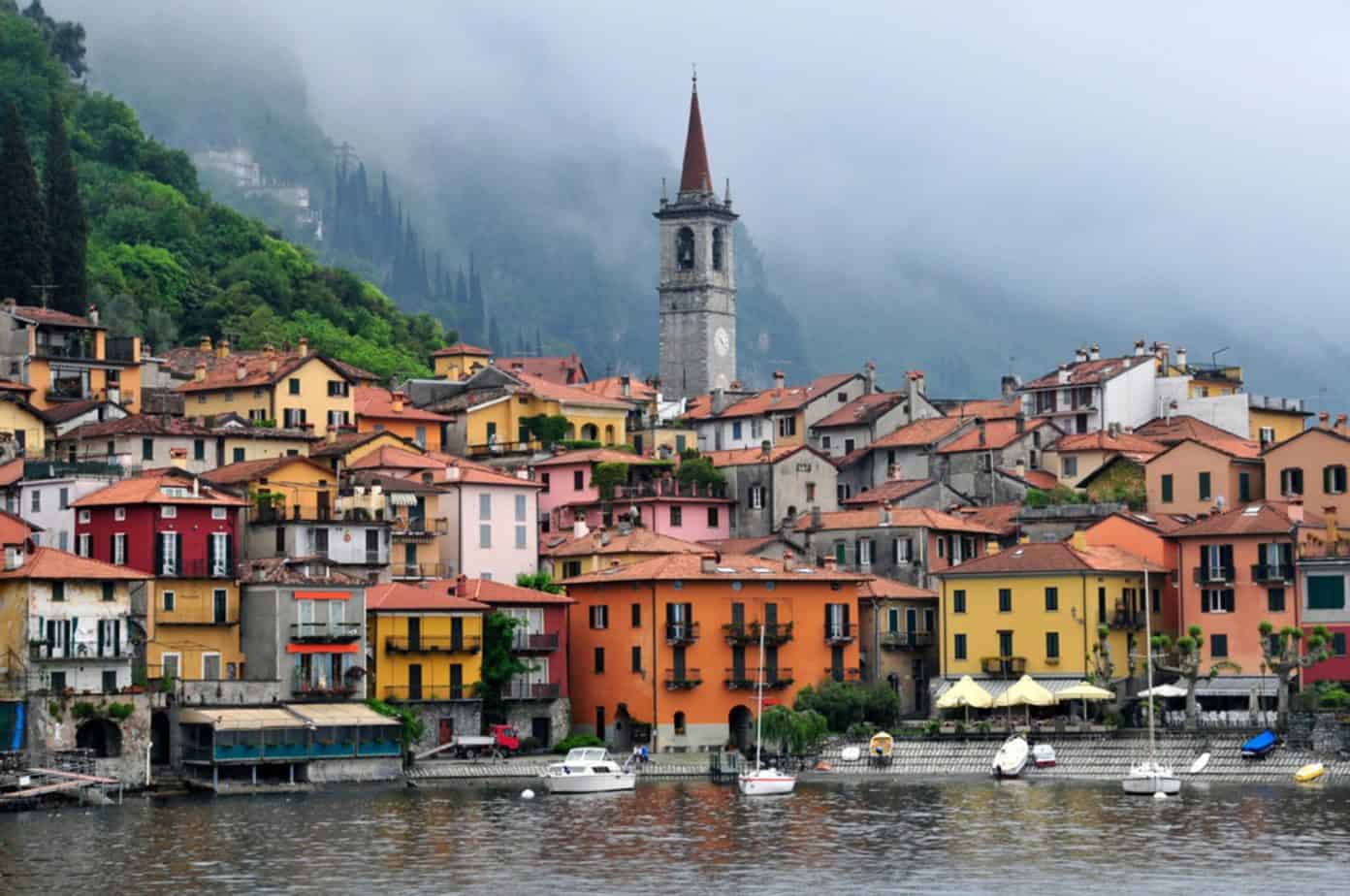
Varenna (pop. 812)
OK, the world knows Lake Como. The world does not know Varenna. It’s on the east side of the lake, directly opposite Bellagio. What people don’t know is Varenna battles Bellagio for the title of prettiest town on the lake. A collection of pastel-colored buildings hugging the lake greets you as Como’s public boat motors into the small port.
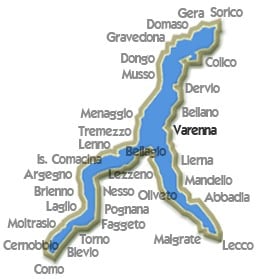
Varenna gets my vote. Then again, mobs of tourists in ballcaps tend to deface beautiful villages such as Bellagio.
Varenna doesn’t get the crowds. I found myself alone walking down a cement path lined with palm trees and bougainvilleas, with tall cliffs on one side and a Lake Como so clear I could see fish swimming below the surface.
I walked to Villa Monastero, a one-time monastery in the 11th and 12th centuries that’s now in a huge garden with a palace showing off garish furniture inside.
Founded by fishermen in 769 AD, Varenna is a pleasant place to unwind and get away from Italy’s summer crowds. In July and August, Lake Como is also warm enough to swim.
Varenna is an hour by boat from the city of Como, which is 37 miles from Milan.



August 25, 2020 @ 9:33 am
Great article ! I appreciate the indications to reach those places by public transports !